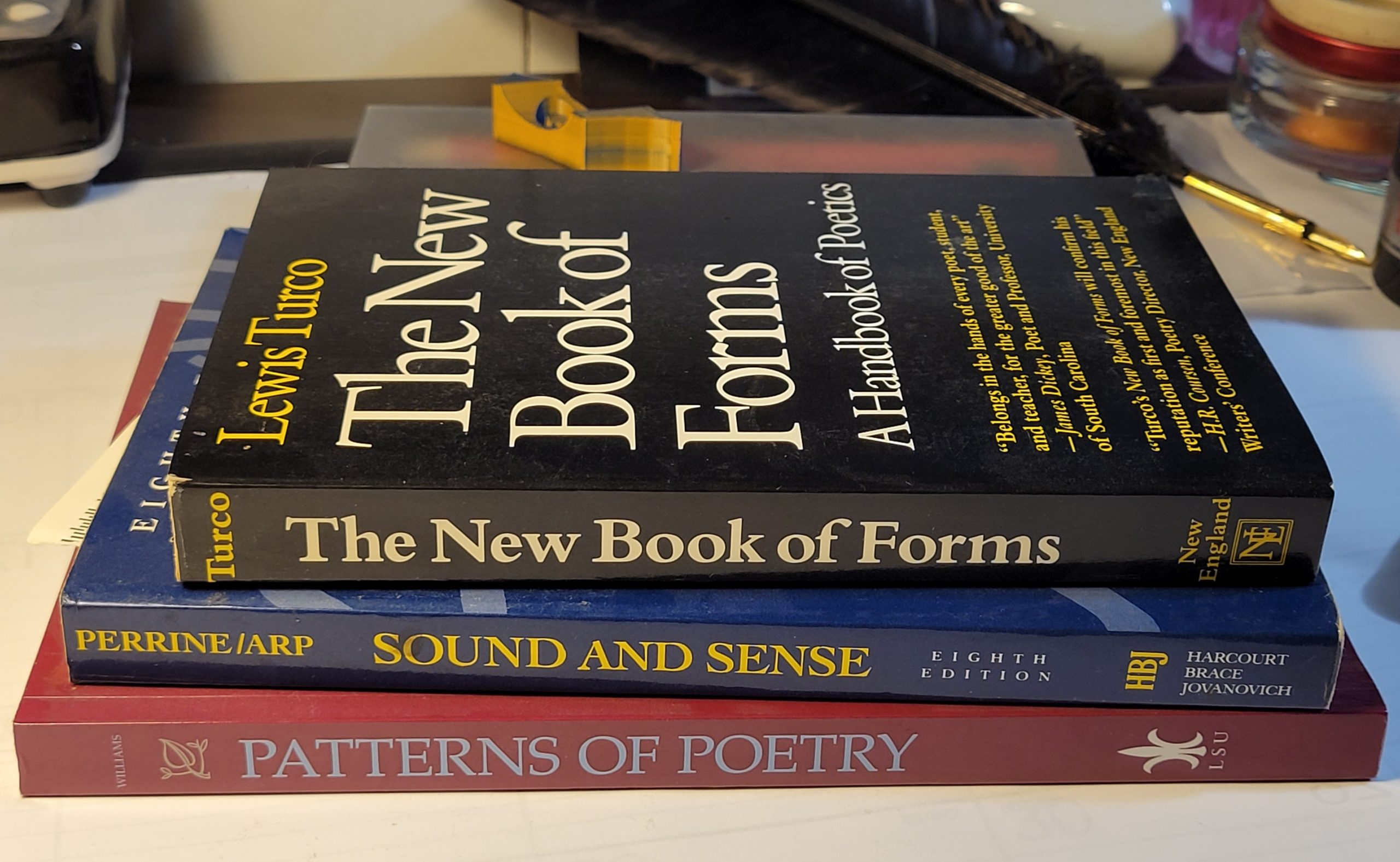For most of my writing life, my poetry has been free verse. It seems to go well with my style, which often has a conversational tone. In my poetry workshop class in college, I’d had to try some forms, including the obligatory sestina. It wasn’t my favorite experience. More recently, I’ve tried a couple of forms and actually found some pleasure and purpose. I’ve learned a few things and thought I would share some reasons why to try forms and a few tips on how to go about it.
Reason 1: Structure
Trying to write in a form will make you more aware of the structure. Even if you don’t think your form poem is successful, look at how the line and stanza breaks affect the flow of the poem. Adapt this knowledge when you go back to free verse. I have become better at breaking my own poems into stanzas instead of a solid block of text.
Tip 1: Read Modern Examples
Find modern poems written in your chosen form and then read and re-read them. We all cut our teeth reading sonnets by William Shakespeare and Elizabeth Barrett Browning. They wrote in eras when “thee” and “thou” were commonplace. Don’t mistake the vocabulary for the form. Don’t throw archaic language into your sonnet unless you are trying to make a point. Find poems by writers whose work lives in today, such as:
- Pablo Neruda, sonnet –https://allpoetry.com/poem/14326625-Sonnet-Lxxxi-by-Pablo-Neruda
- Adrienne Rich, sonnet – https://contagiousgothic.wordpress.com/2017/08/28/sonnet-vii-1978-adrienne-rich/
- Billy Collins, sonnet – https://writersalmanac.publicradio.org/index.php%3Fdate=2007%252F09%252F15.html
- Tracy K. Smith, ghazal – https://poets.org/poem/ghazal-1
- Alicia Ostriker, ghazal – https://poets.org/poem/ghazal-america-beautiful
- Jodi L. Hottel, pantoum – https://arthonorslife.wordpress.com/2011/08/30/a-londonberry-poets-pantoum-to-a-modern-urn/
Reason 2: Examining Your Lines
Trying to fill a line with the correct number of syllables, rhyme scheme, etc. will make you take a more intense look at each line in your poem. While writing a sonnet, for example, I needed more syllables and yet didn’t want “filler.” It made me find a way to say what I wanted at a deeper level. Instead of trying to tighten my line to as few words as possible to say what I wanted, I breathed into the line’s constraints and said more.
Tip 2: Practice Identifying Meter
If you aren’t used to looking for the feet in a line and are out of practice looking for the beats, it can be difficult to meet a form’s requirements. I found some practice was useful. Check out this tool by the University of Virginia’s Department of English: https://prosody.lib.virginia.edu/ . It gives you interactive practice in determining the meter and feet. This will help brush up your comfort with iamb (da DUM) vs trochee (DUM da) and all the rest.

Reason 3: Increased Flow
Writing in a form that imposes some type of rhythm will make your poem flow. There’s a reason nursery rhymes and songs can stick with us. Our ears like things that have a rhythm to them. You don’t want to go too far and make your poem sing-songy. That leads to my next tip.
Tip 3: Use Variety
If you analyze one of those sonnets we were taught, you’ll find that strict iambic pentameter isn’t used 100% of the time. Every now and then, a meter will be trochee or anapest (da da DUM) instead of iambic. Not every rhyme will be exact. The occasional near rhyme or switched up meter keeps the reader or listener interested. Unlike a drummer keeping time for the band, it’s okay to be a little bit off now and then. It is a good idea, and intentionally switching the beat in a specific place can add emphasis to your words.
Reason 4: Explore
Doing research on what forms are out there can open you up to a new world of poetry. We tend to hear about sonnets and sestinas and haiku, but what about pantoum (Malaysian), ovillejo (Spanish), clogyrnach (Welsh), or rubyaiyat (Persian)? Love of interesting language is universal and this is a cool way to get exposed to something new.
Tip 4: Relax
Unless you are trying to get your poem published in a form-specific journal, don’t sweat it. There are literary journals that state they accept poetry in forms (like “Rattle” and “Blue Unicorn”), as well as journals dedicated to specific forms, such as haiku (“Haiku Journal” published by Prolific Press).
Almost any form has its subtleties. For example, haiku is not only about syllable count. There are other requirements, like having a nature reference, having a turn, and so on. There are a ton of people who will gladly tell you where you’ve gone wrong. Take them with a grain of salt but learn from their feedback.
If your goal is to write a good poem, then write the best poem you can, using the constraints of the form as closely as you can. If your turn comes in the wrong line, so be it. You might not fare well with a journal dedicated to that specific form (but you never know until you try). Other venues might be happy to see that poem.
Reason 5: Nonce Forms
This one is also partly a tip. Did you know there is something called a “nonce” form? You create a form that you use. It could be for one poem or you might do multiple using it. You’ve probably already done this without calling it a form. Ever decide that your poem fits better in three stanzas of specific lengths? Create your own rhyme scheme, just because it seems to work? Who knows, you might create a form and have it catch on.
Tip 5: Enjoy the Process
Have fun. Stretch your writing wings. Give yourself a challenge and see what happens. Not every poem in a form will succeed, but not everything in free verse does either. Experiment and enjoy the process.
Bonus Tip: Resources.
- For a glossary of poetic terms, see the Poetry Foundation: https://www.poetryfoundation.org/education/glossary
- The Book of Forms: A Handbook of Poetics by Lewis Turco
- Sound and Sense by Laurence Perrine and Thomas R. Arp
- Patterns of Poetry: An Encyclopedia of Forms by Miller Williams


Leave a Reply